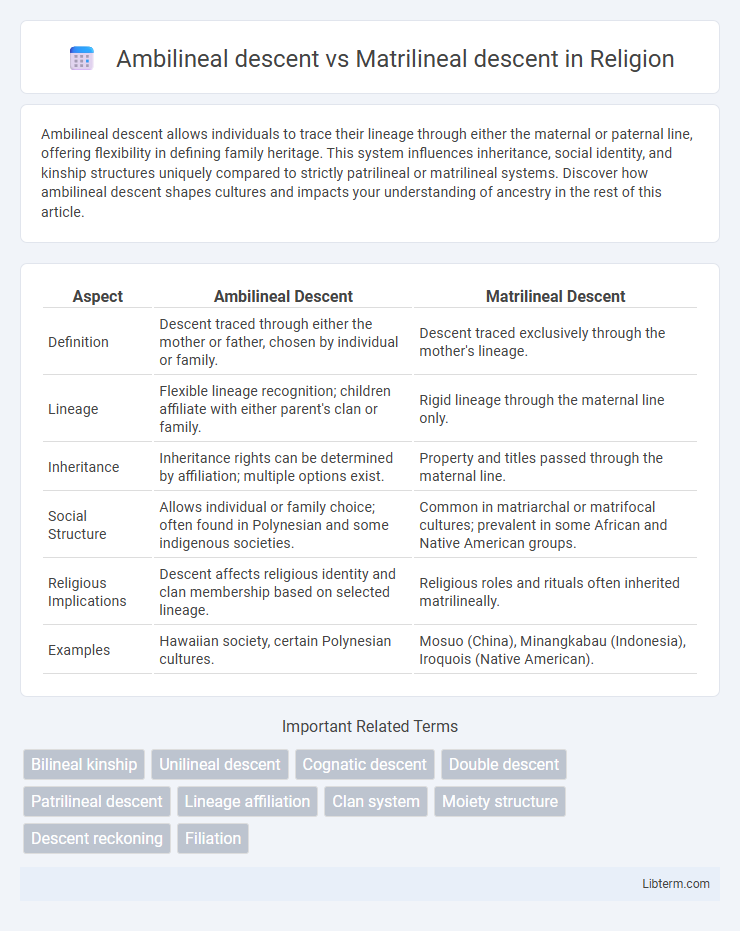Ambilineal descent allows individuals to trace their lineage through either the maternal or paternal line, offering flexibility in defining family heritage. This system influences inheritance, social identity, and kinship structures uniquely compared to strictly patrilineal or matrilineal systems. Discover how ambilineal descent shapes cultures and impacts your understanding of ancestry in the rest of this article.
Table of Comparison
| Aspect | Ambilineal Descent | Matrilineal Descent |
|---|---|---|
| Definition | Descent traced through either the mother or father, chosen by individual or family. | Descent traced exclusively through the mother's lineage. |
| Lineage | Flexible lineage recognition; children affiliate with either parent's clan or family. | Rigid lineage through the maternal line only. |
| Inheritance | Inheritance rights can be determined by affiliation; multiple options exist. | Property and titles passed through the maternal line. |
| Social Structure | Allows individual or family choice; often found in Polynesian and some indigenous societies. | Common in matriarchal or matrifocal cultures; prevalent in some African and Native American groups. |
| Religious Implications | Descent affects religious identity and clan membership based on selected lineage. | Religious roles and rituals often inherited matrilineally. |
| Examples | Hawaiian society, certain Polynesian cultures. | Mosuo (China), Minangkabau (Indonesia), Iroquois (Native American). |
Introduction to Kinship Systems
Ambilineal descent allows individuals to trace their ancestry through either the mother or the father, offering flexible affiliation within kinship systems. Matrilineal descent strictly follows the mother's lineage, emphasizing inheritance and social identity through maternal lines. These kinship structures shape familial roles, inheritance patterns, and social organization across diverse cultures.
Definition of Ambilineal Descent
Ambilineal descent is a kinship system where individuals trace their lineage through either the mother's or the father's line, allowing flexible affiliation with either parental group. Unlike matrilineal descent, which exclusively follows the mother's ancestry, ambilineal descent permits choice or variation in lineage affiliation based on social, cultural, or personal factors. This system is common in societies where heritage, inheritance, or identity is not rigidly assigned to a single parental line.
Definition of Matrilineal Descent
Matrilineal descent is a kinship system where lineage, inheritance, and social identity are traced exclusively through the mother's line, emphasizing female ancestry as the primary link between generations. This system contrasts with ambilineal descent, which allows individuals to affiliate with either the mother's or father's lineage, offering flexible family ties. Matrilineal societies often organize property rights, clan membership, and succession based on maternal relationships, affecting social structure and cultural norms.
Key Differences Between Ambilineal and Matrilineal Descent
Ambilineal descent allows individuals to trace lineage through either the mother's or father's side, providing flexibility in inheritance and social identity, while matrilineal descent strictly follows the maternal line for determining kinship and inheritance. In ambilineal systems, descent groups are less rigid, often permitting personal choice or societal factors to influence lineage affiliation, contrasting with matrilineal systems where property and social status consistently pass through female ancestors. These distinctions impact familial roles, inheritance rights, and social organization within cultures practicing these forms of descent.
Cultural Examples of Ambilineal Descent
Ambilineal descent allows individuals to trace their lineage through either the mother or father, offering flexibility in cultural identity and inheritance. Societies such as the Polynesian Maori and some Native Hawaiian communities practice ambilineal descent, integrating kinship ties based on social and economic advantages rather than strict paternal or maternal lines. This contrasts with matrilineal descent systems found among the Akan of Ghana, where lineage and inheritance pass exclusively through the female line.
Societies Practicing Matrilineal Descent
Societies practicing matrilineal descent trace lineage and inheritance through the mother's line, often seen in communities like the Minangkabau of Indonesia and the Khasi of India. This system influences property rights, social roles, and clan membership, emphasizing the maternal connection in kinship and succession. Matrilineal descent contrasts with ambilineal descent, where lineage can be traced through either parent, allowing more flexibility in familial affiliation and inheritance.
Inheritance Patterns in Ambilineal Systems
In ambilineal descent systems, inheritance patterns are flexible, allowing individuals to affiliate with either the mother's or father's lineage based on social, economic, or personal factors. Property, titles, and family responsibilities can be passed through either line, often determined by contemporary needs or agreements within the community. This contrasts with matrilineal systems, where inheritance and descent are strictly traced through the mother's line, creating more rigid and predictable patterns of succession.
Lineage and Identity in Matrilineal Societies
Matrilineal descent traces lineage exclusively through the mother's line, shaping identity and inheritance within the maternal clan. This form of descent emphasizes female kinship ties, granting women central roles in social organization and property transmission. In contrast to ambilineal systems, matrilineal societies maintain stable lineage groups that reinforce collective identity based on maternal ancestry.
Social Implications of Descent Systems
Ambilineal descent allows individuals to affiliate with either the maternal or paternal lineage, fostering flexible kinship ties and potentially broader social networks, which can enhance resource sharing and alliance building. Matrilineal descent centers inheritance and social identity through the mother's line, often resulting in stronger maternal kin support and distinct gender roles, as seen in many Indigenous communities. These social implications affect property rights, succession, and community cohesion, influencing how societies organize family obligations and social responsibilities.
Conclusion: Comparing Ambilineal and Matrilineal Descent
Ambilineal descent combines flexibility by allowing individuals to affiliate with either the mother's or father's lineage, promoting broader kinship connections and inheritance options. Matrilineal descent, in contrast, emphasizes lineage through the mother's line, often ensuring more stable and clear inheritance patterns within maternal kin groups. Comparing these systems reveals ambilineal descent supports social adaptability, while matrilineal descent reinforces consistent lineage identity and intergenerational continuity.
Ambilineal descent Infographic

 libterm.com
libterm.com